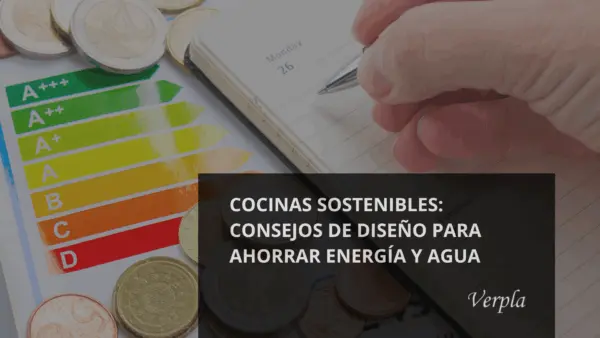Today, sustainable kitchen design has gone from being a trend to a necessity. Saving energy and water in this space of the home not only contributes to the protection of the environment, but also means significant savings on bills in the long term. In addition, an efficient kitchen design combines style, functionality and environmental responsibility, allowing our daily habits to have a lower impact. Below, we explore several tips for creating a more sustainable and efficient kitchen.
1. Choose Energy-Efficient Appliances to Save Energy and Water
Household appliances are responsible for a large part of the energy consumption in the kitchen. By selecting high-efficiency models, such as those with A+++ energy certification or higher, you will be significantly reducing electricity consumption. For example, opting for an efficient refrigerator, dishwasher and oven guarantees a reduction in energy consumption. In kitchens such as those we offer at Verpla Interiorisme, we collaborate with suppliers who offer state-of-the-art and efficient appliances, which makes it easier to choose more sustainable models. Hacker kitchens, for example, incorporate high-efficiency appliances with advanced energy- and water-saving features.
2. Use LED Lighting to Save on Power Consumption
LED lighting is one of the most effective options for reducing electricity consumption in the kitchen. These lights consume up to 80% less energy than traditional bulbs and last much longer, thus reducing waste and the need for frequent replacements. LEDs are ideal for illuminating key areas, such as work areas or space under cabinets, providing efficient lighting without increasing consumption. In kitchen projects in Sant Cugat and elsewhere, LED lighting has proven to be not only efficient, but also a way to improve the aesthetics of the space.
3. Install Water-Efficient Faucets
Water is another valuable resource in the kitchen. Opting for low-flow faucets or those that include aerators is a great way to reduce consumption without sacrificing pressure. These devices mix air with water, generating optimal pressure with less volume, which is ideal for washing dishes and other everyday uses. Another excellent option is faucets with motion sensors, which allow you to control the flow of water precisely. At Verpla, we offer advice to integrate these elements into the design, ensuring that functionality and style are maintained.
4. Choose sustainable and durable materials
When we talk about sustainability in kitchen design, materials play a fundamental role. Opt for resistant surfaces with a low environmental impact, such as bamboo or certified wood, which are renewable and durable. There are also countertops and furniture made from recycled materials, such as recycled glass or quartz, which are not only sustainable, but also resistant and easy to maintain. At Verpla Interiorisme, we offer a wide range of options to choose sustainable materials without compromising on design.
5. Make the most of natural light and ventilation
A design that allows natural light to be used is key to reducing electricity consumption. If possible, consider opening large windows or skylights to illuminate the kitchen during the day, which not only reduces electricity costs, but also provides a warm and inviting atmosphere. In addition, good ventilation prevents moisture build-up and the need for frequent exhaust fans. These details are especially important in German kitchens in Barcelona or other locations, where natural light and minimalist design come together to create a functional and sustainable space.
6. Makes recycling and composting easier
A sustainable kitchen not only means saving water and energy, but also responsible waste management. To do this, integrate a space dedicated to recycling in your kitchen. It uses separate compartments for plastics, glass, paper and organic waste, which facilitates daily recycling. In addition, composting organic waste helps reduce the amount of trash, while also producing natural compost for plants. At Verpla Interiorisme, apart from designing kitchens with specific areas for recycling, integrating aesthetics and functionality, we have the collaboration of HÄCKER , which uses ecological materials to help the environment.
7. Implement an efficient distribution of space
The distribution of elements in the kitchen also plays a role in sustainability. For example, placing the refrigerator away from heat sources, such as the oven or stove, helps it not consume additional energy to stay cool. In addition, having cleaning utensils and products at your fingertips reduces search time and improves efficiency in daily tasks. This type of design can be found in various home renovations, where optimal organization is prioritized to achieve a functional and efficient space.
Conclusion
Achieving a sustainable kitchen is a combination of strategic decisions and a focus on efficiency and respect for the environment. From choosing efficient appliances to integrating recycled materials, each step contributes to creating a more environmentally friendly space. At Verpla Interiorisme, we are committed to designing sustainable kitchens that are not only aesthetically pleasing, but also responsible and practical. Incorporating these tips into your kitchen will help you reduce your environmental impact and enjoy a modern, efficient space in tune with nature.

